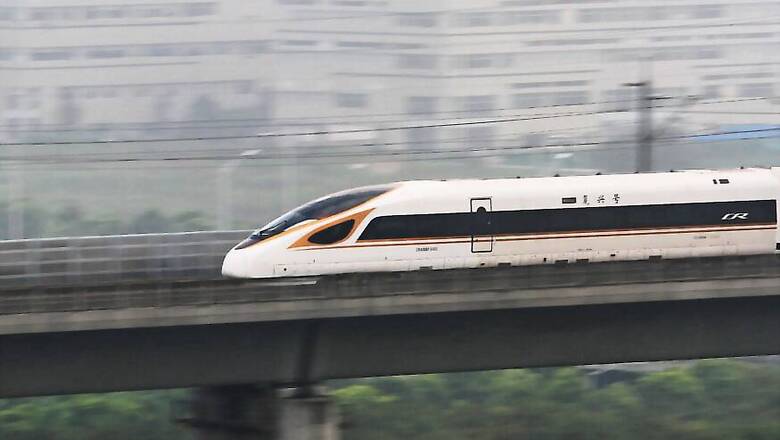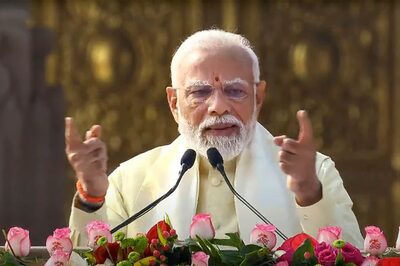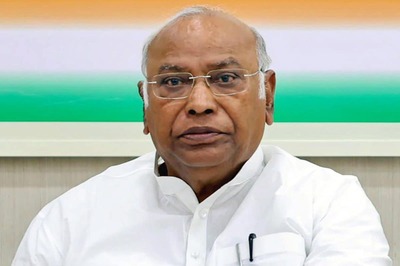
views
New Delhi: One of India's most ambitious projects may already be staring at a delay in launch due to land acquisition troubles, but Ministry of Railways is leaving no stone unturned in heaping the upcoming bullet train, running between Mumbai and Ahmadabad, with features that Indian trains have never seen before.
To begin with, passengers will get a dedicated room for child feeding, there will be facilities for sick persons and separate washrooms for men and women— all these being firsts on the Indian rail network. Each train will have 55 seats for business class and 695 seats for standard class. There will be dedicated luggage space for passengers.
The E5 Shinkansen series bullet trains to be pressed into service will also have baby changing rooms comprising baby toilet seats, tables for diaper disposal and a low sink for children for washing hands.
There will also be two extra-spacious toilets for wheelchair-bound passengers in the 10-coach high-speed train.
According to the blueprint finalised by the Railways, the 750-seater E5 Shinkansen, a new generation Japanese high-speed train, will also introduce wall mounted type urinals for men, according to a senior Railway Ministry official working with the Rs 1 lakh crore project.
Urinals and toilets will be installed in alternate coaches in the train. For example, toilets will be installed in coach number 1, 3, 5, 7 and 9 while urinals will be available in coach number 2, 4, 6 and 8. Washrooms for men and women will also be placed in a similar way. Coaches will also have automatic seat rotation system.
There will be a freezer, hot case, boiling water facility and tea and coffee maker in the train while a hand towel warmer will be provided in business class.
Coaches will have LCD screens to display current station, next stopping station and destination, schedule and expected time to reach next stop and destination stations.
Railways is gearing up to acquire 25 E5 series bullet trains from Japan at an estimated cost of about Rs 5,000 crore.
Most of the Mumbai-Ahmedabad corridor will be elevated, except for a 21 km underground tunnel between Thane and Virar, of which 7 km will be under the sea.
The undersea tunnel was chosen to avoid damaging the thick vegetation present in the area, said the official.
The corridor will begin at the underground station in the Bandra-Kurla Complex in Mumbai, and then traverse 21 km underground before emerging above ground at Thane.
The bullet train is aerodynamically designed with a long nose. When a high speed train exits a tunnel a blasting sound is generated due to micro pressure waves. To reduce this micro pressure, the front car is designed with a nose section, said the official.
The coach body is pressurized to avoid discomfort to passengers due to drop in pressure inside the passenger cabin tunnel.
Bullet train will take about 2 hours and 7 minutes to travel the 508-km distance between Mumbai and Ahmedabad.
Indian Railways will invest Rs 9,800 crore in the high-speed rail project and the remaining cost will be borne by the state governments of Maharashtra and Gujarat.
However, Prime Minister Narendra Modi's ambitious Japan-backed Mumbai-Ahmedabad bullet train project costing USD 17 billion must speed up to meet the August 2022 deadline. The biggest challenge for the project is land acquisition.
The National High Speed Rail Corporation Limited (NHSRCL) is acquiring around 1,400 hectares of linear land at a cost of Rs 10,000 crore in 195 villages in Gujarat and in 104 in Maharashtra and a small area in Dadra & Nagar Haveli.
It has faced stiff resistance from farmers and tribals, especially in the Palghar district of Maharashtra.
NHSRCL has to complete land acquisition by December 2018. So far only 0.9 hectares in Bandra-Kurla Complex has been physically handed over, according to a report in The Indian Express. Before the acquisition process, an aerial survey is conducted to identify the land.
The results of the aerial survey are verified with a physical survey. After that a joint measurement survey is done by a team of all stakeholders. The compensation process begins on the basis of this survey. While the aerial survey was completed early last year, the physical survey, started in December, has covered 184 villages in Gujarat and 50 in Maharashtra.
Five petitions have been filed in the Gujarat High Court — either challenging a 2013 Gujarat amendment to the Land Acquisition Act, demanding the preliminary notification be quashed, or refusing to part with fertile land. The Godrej group has filed a petition In Bombay High Court challenging acquisition of its 3.5 hectares in Vikhroli. It has offered another piece of land close by.
NHSRCL has adopted different compensation mechanisms in the two states due to different laws. In Maharashtra, the company is paying four times the circle rate of the land, plus a 25 percent bonus, as well as a one-time payment of Rs 5 lakh. If one loses a house, he or she can choose either a new one built nearby (500 sq feet) or money to buy a new house elsewhere at twice the construction cost. For livelihood loss, the offer is Rs 3,600 per month for one year.
There is a provision for a one-time, Rs 5 lakh rehabilitation payment to landless agriculture workers, and a one-time. Rs 25,000 to employees of shops on land to be acquired. Even for forest land, the project is paying 50 percent of land cost to the displaced and the remaining 50 percent to the state government. For fruit-bearing trees axed, farmers are being offered the amount expected to be earned for the remainder of the tree’s lifetime. Besides, the company pays a 12 percent interest on the compensation amount to be calculated from the date of notice
Apart from compensation, there are several other issues such as the impact of the project on resources, restrictions on activities and vibrations from the train. Since bullet train is a high-speed train, its track has to avoid curves and be as straight as possible. That requires splitting of farm land at several places which can disrupt farm operations.
For land being split, the company is paying a special compensation based on the extent — a 50-50 split has a different compensation from, say, 75-25. The land that remains on either side continues to belong to the owner, who can use it as he or she wishes. Only for digging and building a highrise will he need to inform the NHSRCL. The company has responded to the villagers' demands of proving amenities such as healthcare, education, drinking water and sanitation.




















Comments
0 comment